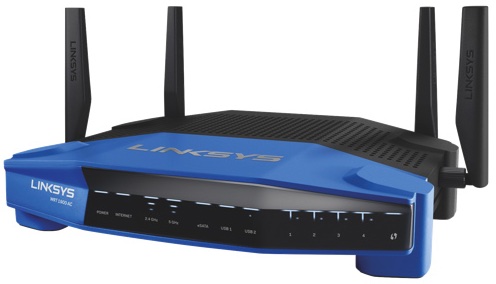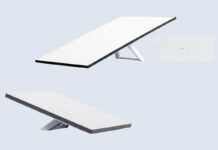
Wireless routers play an important role in how virtually all of your consumer electronics perform, but they’re often in the background and forgotten about. Not this year. In 2014, they became a big deal again, as the number of connected devices in homes exploded and a new Wi-Fi standard —802.11ac (or Gigabit Wi-Fi)— went mainstream. I’ve put together a list of five of the best Wi-Fi routers released in a year that saw many “firsts” and “bests” released.
 Linksys Tri-Band Wireless AC3200 Gigabit Router
Linksys Tri-Band Wireless AC3200 Gigabit Router
Linksys is targeting households with lots of connected devices and an under-performing Wi-Fi network with its latest router, the Tri-Band Wireless AC3200 Gigabit router.
It’s got plenty of speed and advanced technology to maximize delivery if raw throughput is your goal. Each of its two 5GHz radios can send data at the rate of 1300 Mbps, while the third 2.4 GHz radio can transmit at 600 Mbps. It also utilizes beam forming and dynamic band steering to optimize those connections. A trio of manually adjustable antennas and Smart Wi-Fi software make it easier for the user to take optimization to the next level, including prioritizing traffic for specific media or applications.
In my review of this wireless router, I was able to show just how big an impact Linksys’ optimization technology and easy-to-use software combined to make a dramatic difference in the performance of my Wi-Fi network.
Asus RT-AC66R Dual-Band Wireless AC 1750 gigabit Router
The Asus RT-AC66R has won accolades for its power, value and looks. And while there were some early issues reported with this router’s performance using the 2.4GHz band, Asus released a firmware update in October that’s solved that issue, making it a great all-round choice.
Asus designed the RT-AC66R to be looked at, not just stuck in a corner —because not everyone can hide their wireless router and if you stick it out of sight, that can result in less than stellar performance. This router looks good with a nicely patterned black case with blue LED indicator lights. It can be positioned upright, placed horizontally or even wall-mounted.

Naturally, it supports 802.11ac and has dual-band (2.4GHz and 5GHz) radios for a combined maximum of 1750 Mbps. Asus uses its proprietary AiRadar system, combining high powered amplification, three adjustable external antennas and beam packaging to intelligently strengthen the signal received by wireless devices using your Wi-Fi network.
The router is also DNLA Server compatible, meaning you can attach a USB drive (there are two USB ports available) and stream media directly from that hard drive to a DNLA-compatible device, including game consoles, tablets and Smart TVs.
 Netgear Nighthawk X6 AC3200 Wireless Router
Netgear Nighthawk X6 AC3200 Wireless Router
My home is exactly the environment where the Netgear Nighthawk X6 excels.
I have multiple Apple TVs streaming HD media content throughout the house. Multiple video game consoles, frequently playing online games. There are multiple PCs and laptops connected at any given time. Connected devices like thermostats, lights and wireless cameras are online at all times. Airplay speakers are using the Wi-Fi for streaming music. Automated wireless data backup is underway constantly. And then there’s the assortment of smartphones and tablets a family of five carries around, along with the devices brought over by visiting friends and family.
This is a nightmare scenario in terms of network congestion —far more devices and far more bandwidth demand than my old Wireless N router was every designed to handle. The results of that congestion make themselves very apparent with streaming video that pauses to cache, web pages that sometimes take forever to load, and some young gamers who get very peeved when their Xbox Live connection gets laggy.
As I mentioned during my review of the Netgear Nighthawk X6, this was the fastest router I tested this year. Like the Linksys Tri-Band Wireless AC3200 Gigabit router, this a tri-band 802.11ac router that can manage a combined throughput of 3200 Mbps on its three radios.
It also has six high-powered, adjustable antennas and beamforming + technology. Within our house, this router immediately improved the signal strength to every device connected to the Wi-Fi network and it dramatically improved the performance of connected devices. For example, the time taken for an Apple TV in a room that’s typically a Wi-Fi challenge zone to spool up a 500MB video file to the point it’s ready to play dropped from close to 40 seconds to just 5 seconds when I installed this router.
The one thing the Netgear Nighthawk X6 didn’t do was offer much of an improvement in the Wi-Fi signal in my back yard. It was better, but not by much —within the house, it’s a champ, though.
D-Link Dual Band Gigabit Wireless Router (DIR-880L)
D-Link’s latest wireless router is its most advanced to date.

The DIR-880L delivers dual-band 802.11ac performance, with 1300Mbps throughput on the 5GHz radio and up to 600Mbps on 2.4GHz. A high powered amplifier, band-steering and AC Smartbeam technology and advanced traffic prioritization ensure optimal performance.
With D-Link’s web-based setup wizard, built-in parental controlsWPA2 security plus dual firewalls and an affordable price, the D-Link DIR-880L is a family-friendly choice for a Gigabit router upgrade.
Linksys WRT1900AC Smart Wi-Fi Router
Finally, my personal favourite router of 2014, the Linksys WRT1900AC Smart Wi-Fi Router.
Put simply, this wireless router is a beast. It’s not a tri-band model, but it is dual-band 802.11ac model with a combined 1900 Mbps on its 5GHz and 2.4GHz radios.
It’s not just the Gigabit Wi-Fi that makes the Linksys WRT1900AC so capable, though. Prioritizing traffic on the fly also requires capable supporting hardware. This thing is packed with high powered components including a dual-core 1.2GHz CPU, 256MB of DDR3 RAM (plus 128MB of Flash Memory), four external adjustable high powered antennas and not just the usual USB 2.0 port for connecting peripherals, but also USB 3.0 and eSATA options. The case has a fan inside to keep things cool with all that silicon muscle.
Linkys’ SMART Wi-Fi software makes the router easy to set up and manage, so you don’t need to be a networking guru to coax this router into delivering impressive performance. But for those who do like to get their hands dirty, the WRT1900AC can be flashed with open source firmware.

I found the WRT1900AC had the power to improve Wi-Fi reception throughout my house, including the zones where signal strength has always been an issue. It also boosted the signal in the back yard. All round, performance was enhanced considerably over the Wireless N router I was using.
The aggressive blue retro look (I’ve heard this router repeatedly referred to as the “classic Linksys WRT54G on steroids”) is a love it or hate it kind of thing, but I think it looks great.
It doesn’t matter which of these wireless routers you choose, if your home Wi-Fi network hasn’t been upgraded in the past year, you are going to see a significant improvement. Even more so if you have any of the smartphones, tablets or PCs that support the latest 802.11ac Wi-Fi standard. And if —like me— you’ve left your wireless router to chug along through the past few years of increasing traffic load, upgrading to one of these five is going to make your W-Fi network feel like it’s been turbo-charged.



